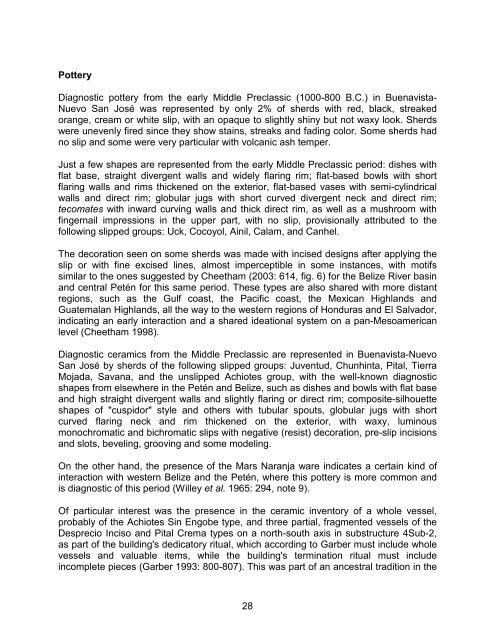Buenavista-Nuevo San José, Petén, Guatemala: Another ... - Famsi
Buenavista-Nuevo San José, Petén, Guatemala: Another ... - Famsi
Buenavista-Nuevo San José, Petén, Guatemala: Another ... - Famsi
Create successful ePaper yourself
Turn your PDF publications into a flip-book with our unique Google optimized e-Paper software.
Pottery<br />
Diagnostic pottery from the early Middle Preclassic (1000-800 B.C.) in <strong>Buenavista</strong>-<br />
<strong>Nuevo</strong> <strong>San</strong> <strong>José</strong> was represented by only 2% of sherds with red, black, streaked<br />
orange, cream or white slip, with an opaque to slightly shiny but not waxy look. Sherds<br />
were unevenly fired since they show stains, streaks and fading color. Some sherds had<br />
no slip and some were very particular with volcanic ash temper.<br />
Just a few shapes are represented from the early Middle Preclassic period: dishes with<br />
flat base, straight divergent walls and widely flaring rim; flat-based bowls with short<br />
flaring walls and rims thickened on the exterior, flat-based vases with semi-cylindrical<br />
walls and direct rim; globular jugs with short curved divergent neck and direct rim;<br />
tecomates with inward curving walls and thick direct rim, as well as a mushroom with<br />
fingernail impressions in the upper part, with no slip, provisionally attributed to the<br />
following slipped groups: Uck, Cocoyol, Ainil, Calam, and Canhel.<br />
The decoration seen on some sherds was made with incised designs after applying the<br />
slip or with fine excised lines, almost imperceptible in some instances, with motifs<br />
similar to the ones suggested by Cheetham (2003: 614, fig. 6) for the Belize River basin<br />
and central <strong>Petén</strong> for this same period. These types are also shared with more distant<br />
regions, such as the Gulf coast, the Pacific coast, the Mexican Highlands and<br />
<strong>Guatemala</strong>n Highlands, all the way to the western regions of Honduras and El Salvador,<br />
indicating an early interaction and a shared ideational system on a pan-Mesoamerican<br />
level (Cheetham 1998).<br />
Diagnostic ceramics from the Middle Preclassic are represented in <strong>Buenavista</strong>-<strong>Nuevo</strong><br />
<strong>San</strong> <strong>José</strong> by sherds of the following slipped groups: Juventud, Chunhinta, Pital, Tierra<br />
Mojada, Savana, and the unslipped Achiotes group, with the well-known diagnostic<br />
shapes from elsewhere in the <strong>Petén</strong> and Belize, such as dishes and bowls with flat base<br />
and high straight divergent walls and slightly flaring or direct rim; composite-silhouette<br />
shapes of "cuspidor" style and others with tubular spouts, globular jugs with short<br />
curved flaring neck and rim thickened on the exterior, with waxy, luminous<br />
monochromatic and bichromatic slips with negative (resist) decoration, pre-slip incisions<br />
and slots, beveling, grooving and some modeling.<br />
On the other hand, the presence of the Mars Naranja ware indicates a certain kind of<br />
interaction with western Belize and the <strong>Petén</strong>, where this pottery is more common and<br />
is diagnostic of this period (Willey et al. 1965: 294, note 9).<br />
Of particular interest was the presence in the ceramic inventory of a whole vessel,<br />
probably of the Achiotes Sin Engobe type, and three partial, fragmented vessels of the<br />
Desprecio Inciso and Pital Crema types on a north-south axis in substructure 4Sub-2,<br />
as part of the building's dedicatory ritual, which according to Garber must include whole<br />
vessels and valuable items, while the building's termination ritual must include<br />
incomplete pieces (Garber 1993: 800-807). This was part of an ancestral tradition in the<br />
28
















